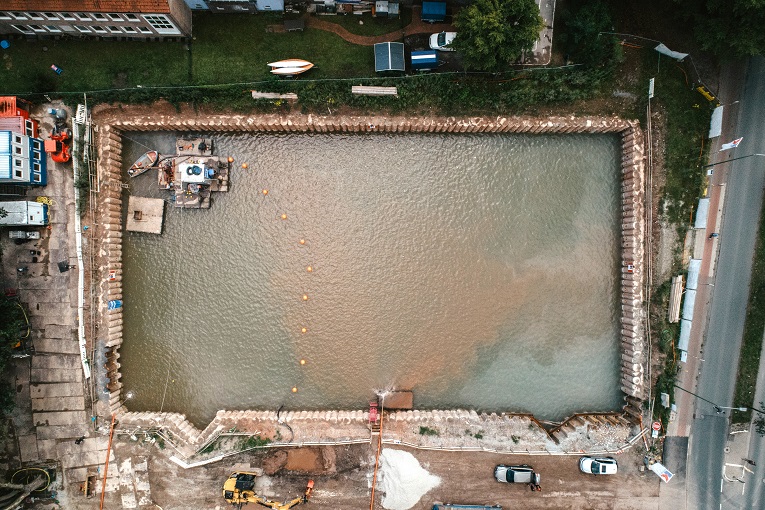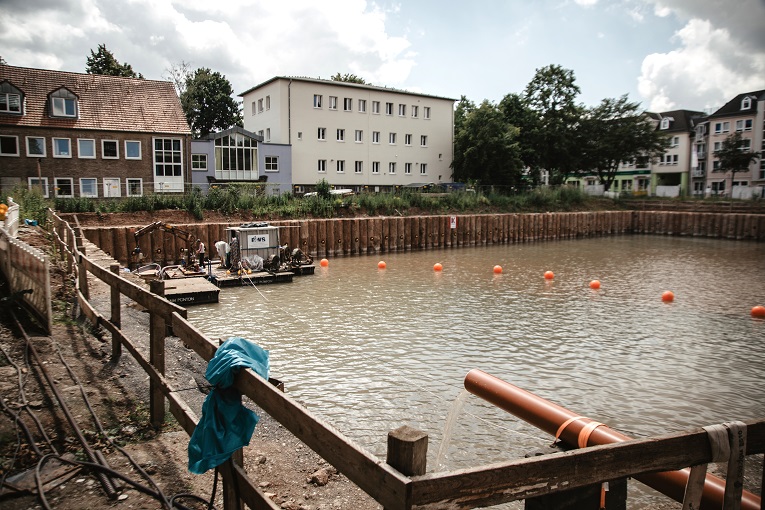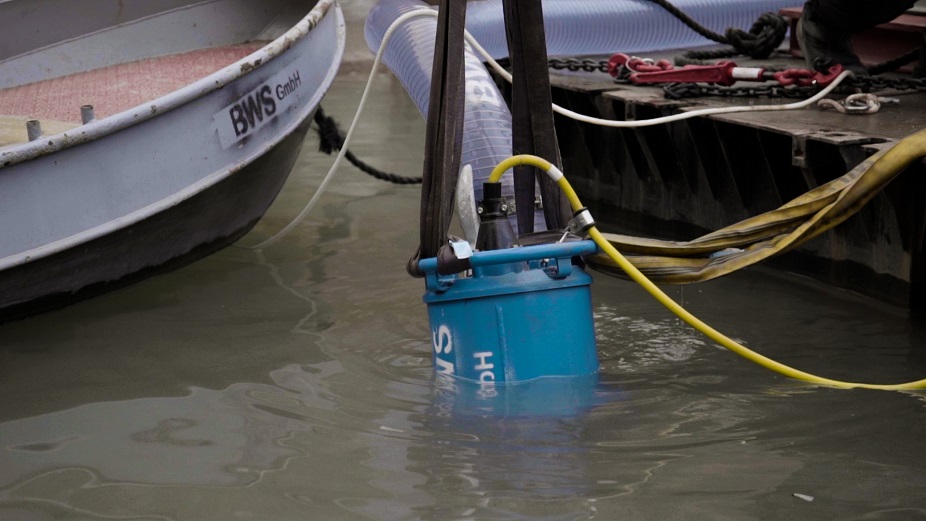


During the construction of a rainwater retention basin, the “hoover of the construction diver” helped to install the underwater concrete floor. Cement suspension, sand, mud and pebbles were removed from the water to prevent hydraulic ground failure.
The higher the property prices means the denser the building development. This has consequences for the urban infrastructure. The German city of Bielefeld is also confronted with the flip side of the building boom as the increasing sealing of the ground makes it more difficult for rainwater to drain. The most recent project of the environ- mental authorities is an underground rainwater retention basin with a capacity of 10,000 m3.
Anchors in the ground For this purpose, a 20 m deep surround- ing bored pile wall was set first. The lower end is formed by the installation of a 110 cm thick concrete base with 2,500 m3 of concrete. The target excavation level lies in the aquifer. In order to prevent the concrete base from being driven up or broken by the groundwater pressure, anchors were inserted 20 m deep into the ground in a 3 x 3 m grid. A particularly unfortunate consequence of this is that during the grouting of the threaded steel elements, excess cement reaches the bottom of the excavation, where it mixes with drilling and ultra-fine slurries.
“You can’t concrete an excavation pit that contains sludge, because this leads to leaks at the wall connections,” explained Marcel Meyer from the commissioned specialist Bautauchen & Wasserbau Sauerland GmbH from Brilon “Meyer continued: “A concrete roller presses the sludge against the walls, later the ground water rises and floods the pit”. In order to prevent a hydraulic ground failure, the sludge deposits, which are semi-hard and hard cement suspensions, must be removed from the entire area.
Important tool The hard elements are recovered individually by divers and brought out of the pit in skeleton boxes. For the rest, made up of mainly larger pieces, Meyer used the “hoover of the construction diver”: a powerful Tsurumi pump which had been slightly modified. Instead of the open suction basket, there is a hose connection at the inlet with the suction nozzle at the other end. The divers bring up the loose floor covering from a depth of 4 m. The mixture is placed in sedimentation tanks where it settles and the solids sink to the bottom, largely freeing the water of sediment and sludge and allowing it to be returned to the pit.
The divers work in group rotation. “All the dismantling work is performed manually,” emphasises Meyer. Good experience has already been gained with the Japanese pumps. They have even proved themselves with water containing bentonite. “There is not much choice on the market”, says Meyer, “because pumps for this work not only have to withstand the difficult medium, but also have to have a long service life.” The concrete floor is scheduled to be constructed in 30 hours periods and two and a half months are estimated just for the preparatory suction work; the divers manage nine to ten hours a day.
The pump used, a GPN 415, is a medium-sized unit from the Düsseldorf-based manufacturer. It achieves a delivery rate of 4110 l/min and a maximum delivery head of 21.5 m. It is remarkable that an agitator pump is used here to remove granular material up to 30 mm in diameter from the excavation pit with apparent ease. The manufacturer has done some preliminary work in the design for this. For example, the GPN is equipped with a double internal mechanical seal without contact with the abrasive pumping medium.
Furthermore, a shaft sleeve with a sealing ring and several sealing lips protects the shaft from the entrained cement particles. Many components such as the impeller and wear plate are made of hardened materials, including extremely hard silicon carbide used for the shaft seal.
Oil lifter The fact that the pump is optimally lubricated in every position is thanks to Tsurumi’s oil lifter, an in-house development. Divers do not have to worry about the issue of tightness either, as the manufacturer hermetically encapsulates each individual electrical conductor in a composite mass.
The pump is the only one on site and the construction divers have full confidence in “their” equipment. A film on Tsurumi’s YouTube channel portrays the project. •






